West Virginia is home to a diverse range of bird species, but perhaps none are more captivating than the birds of prey that soar through its skies. These majestic creatures, also known as raptors, are fierce predators that dominate the food chain in their respective ecosystems.
With their sharp talons, powerful beaks, and exceptional hunting skills, birds of prey play a vital role in maintaining the balance of nature within the state.
From the iconic American bald eagle to the elusive peregrine falcon, West Virginia offers a habitat rich in resources for these magnificent birds.
In this article, we will explore the various species of birds of prey found in West Virginia, their unique characteristics, and the ongoing efforts to protect and conserve these extraordinary creatures.
1. Red-tailed Hawk
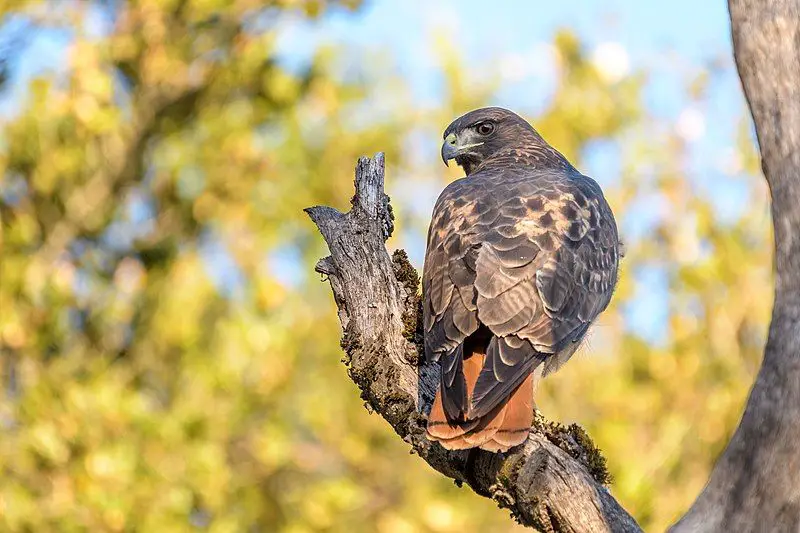
The red-tailed hawk is a type of bird known as a bird of prey. It is found in many different parts of North America. It breeds in a wide range of locations, from the interior of Alaska and northern Canada down to Panama and the West Indies.
This means that you can find red-tailed hawks in many different places throughout North America. The red-tailed hawk belongs to a group of birds called the genus Buteo. This genus includes many different species of hawks.
However, the red-tailed hawk is one of the most common members of this group, both in North America and worldwide.
This means that you are likely to come across a red-tailed hawk more often than other types of hawks within the Buteo genus. The red-tailed hawk is known for its distinctive red tail, which is where it gets its name from.
This feature helps to distinguish it from other types of hawks. However, it is important to note that not all red-tailed hawks have red tails.
Juvenile red-tailed hawks have brown tails, which only turn red as they mature. Red-tailed hawks are known for their impressive hunting skills. As birds of prey, they primarily.
| Kingdom | Animalia |
| Phylum | Chordata |
| Clade | Dinosauria |
| Class | Aves |
| Order | Accipitriformes |
| Family | Accipitridae |
| Genus | Buteo |
| Species | B. jamaicensis |
2. Red-shouldered Hawk
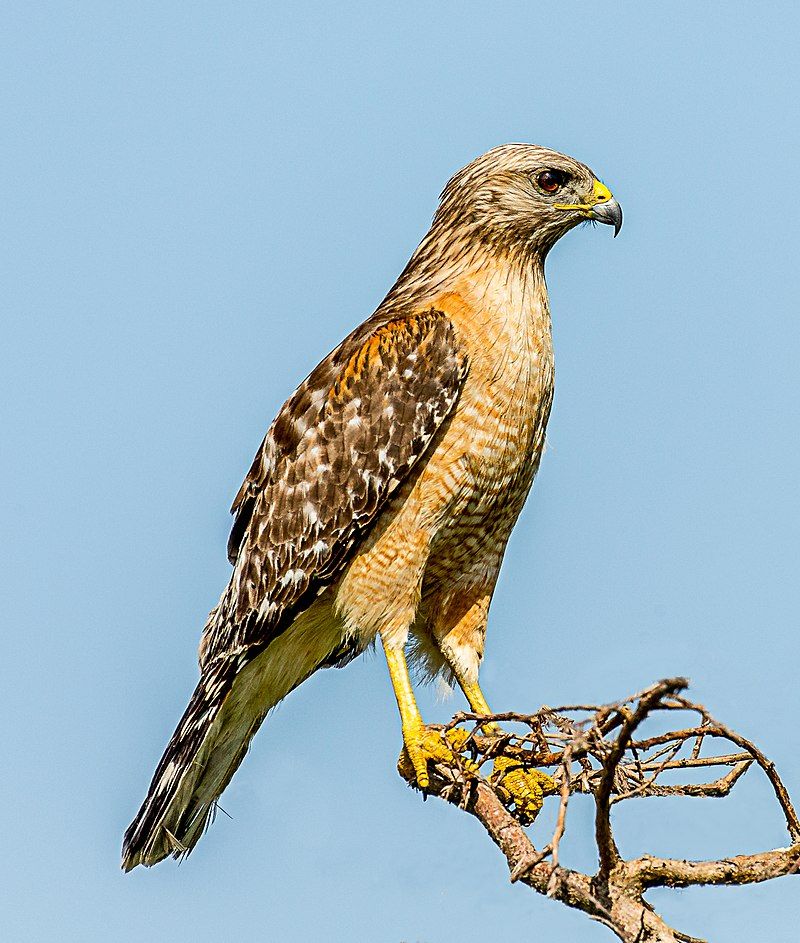
The red-shouldered hawk is a type of bird known as a medium-sized buteo. It can be found in various parts of North America, specifically in the eastern region, along the California coast, and in northern to northeastern-central Mexico.
This bird species is not a migratory one, as it is a permanent resident in most of its range. It chooses to stay in these areas year-round. However, there are some red-shouldered hawks in the northern parts of its range that do migrate.
They typically travel to central Mexico during their migration. The red-shouldered hawk is often seen in forests and woodlands, where it builds its nests and hunts for food. It prefers these types of habitats due to the availability of prey and suitable nesting sites.
These hawks have adapted to living in these environments and have become well-suited to their surroundings. As a medium-sized buteo, the red-shouldered hawk has certain characteristics that distinguish it from other birds.
Its size is not too large nor too small, making it a medium-sized bird. This allows it to have a good balance between agility and strength, which aids in its hunting and survival.One notable feature of the red-shouldered hawk is its red.
| Kingdom | Animalia |
| Phylum | Chordata |
| Class | Aves |
| Order | Accipitriformes |
| Family | Accipitridae |
| Genus | Buteo |
| Species | B. lineatus |
3. Cooper’s Hawk
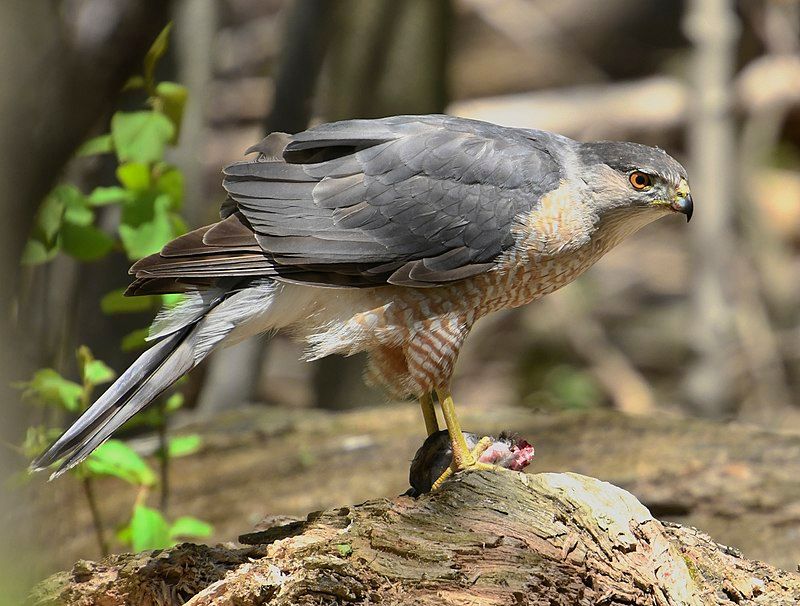
The Cooper’s hawk is a type of hawk that can be found in North America. It is considered to be a medium-sized bird.
This species is native to the continent and is commonly found in various regions ranging from southern Canada down to Mexico. One interesting characteristic of the Cooper’s hawk is its size.
It falls into the category of medium-sized hawks, which means it is neither too big nor too small. This size allows the hawk to adapt and survive in different habitats across North America. The distribution of the Cooper’s hawk is quite extensive.
It can be found in different parts of North America, including southern Canada, the United States, and Mexico.
This wide range of habitats gives the hawk ample opportunities to thrive and establish its presence in various ecosystems. Despite its widespread distribution, the Cooper’s hawk is not evenly distributed throughout its range.
It tends to be more common in certain areas while being less abundant in others. This variation in population density might be influenced by factors such as the availability of prey, nesting sites, and overall habitat suitability. The Cooper’s hawk is known for its hunting skills.
It primarily feeds on small to medium-sized birds, which it catches by surprise using its speed and agility. This hawk is well-adapted.
| Kingdom | Animalia |
| Phylum | Chordata |
| Class | Aves |
| Order | Accipitriformes |
| Family | Accipitridae |
| Genus | Accipiter |
| Species | A. cooperii |
4. Sharp-shinned Hawk
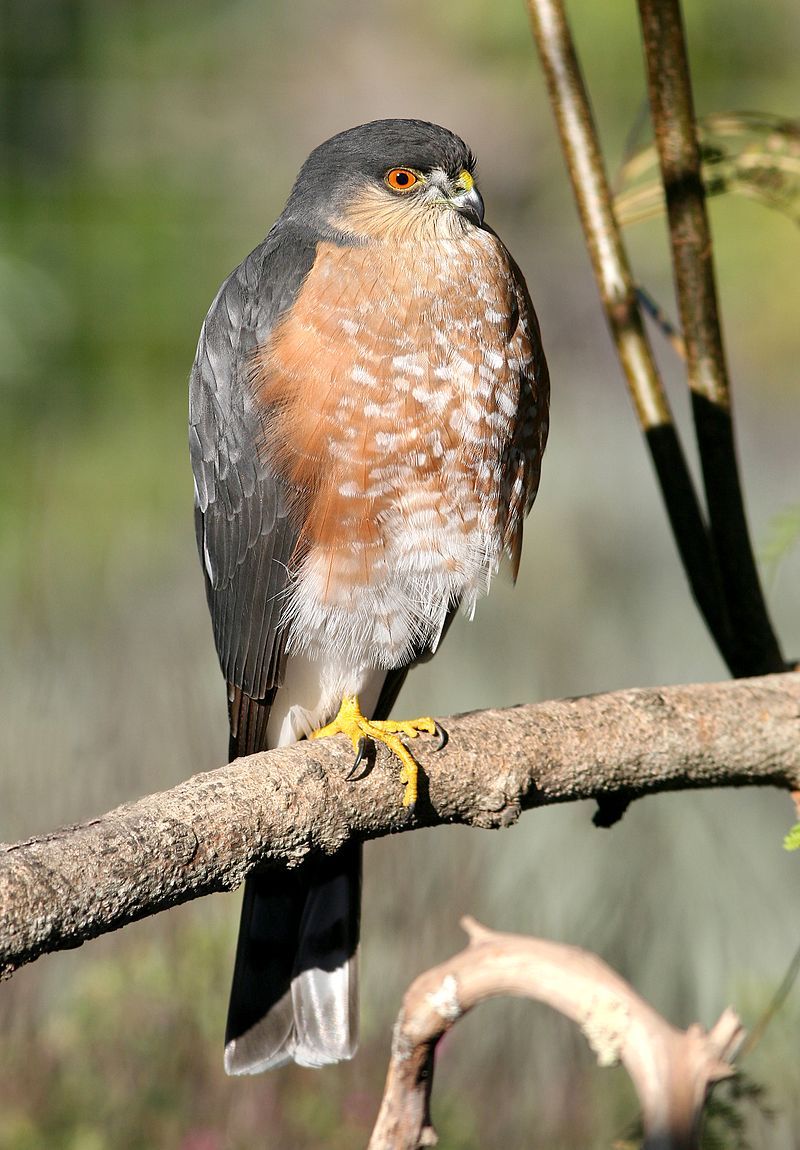
The sharp-shinned hawk, also known as a sharpie, is a small type of hawk. The males of this species are the smallest hawks found in both the United States and Canada.
However, it’s worth noting that the sharp-shinned hawk is still larger than certain Neotropical species, such as the tiny hawk. This particular species of hawk is commonly referred to as a sharpie due to its sharp features and small size.
Although it is small in comparison to other hawks, it is important to understand that it is still larger than certain types of hawks found in the Neotropics, which is a region of the Americas encompassing Central and South America.
The sharp-shinned hawk’s size is noteworthy because it is the smallest hawk species found in both the United States and Canada.
This means that when compared to other hawks that inhabit these regions, the sharp-shinned hawk stands out for its diminutive size.
Furthermore, it is interesting to consider that despite being small in the context of North American hawks, the sharp-shinned hawk is still larger on average than some Neotropical species, such as the tiny hawk.
This suggests that while the sharp-shinned hawk may be small relative to.
| Kingdom | Animalia |
| Phylum | Chordata |
| Class | Aves |
| Order | Accipitriformes |
| Family | Accipitridae |
| Genus | Accipiter |
| Species | A. striatus |
5. Broad-winged Hawk
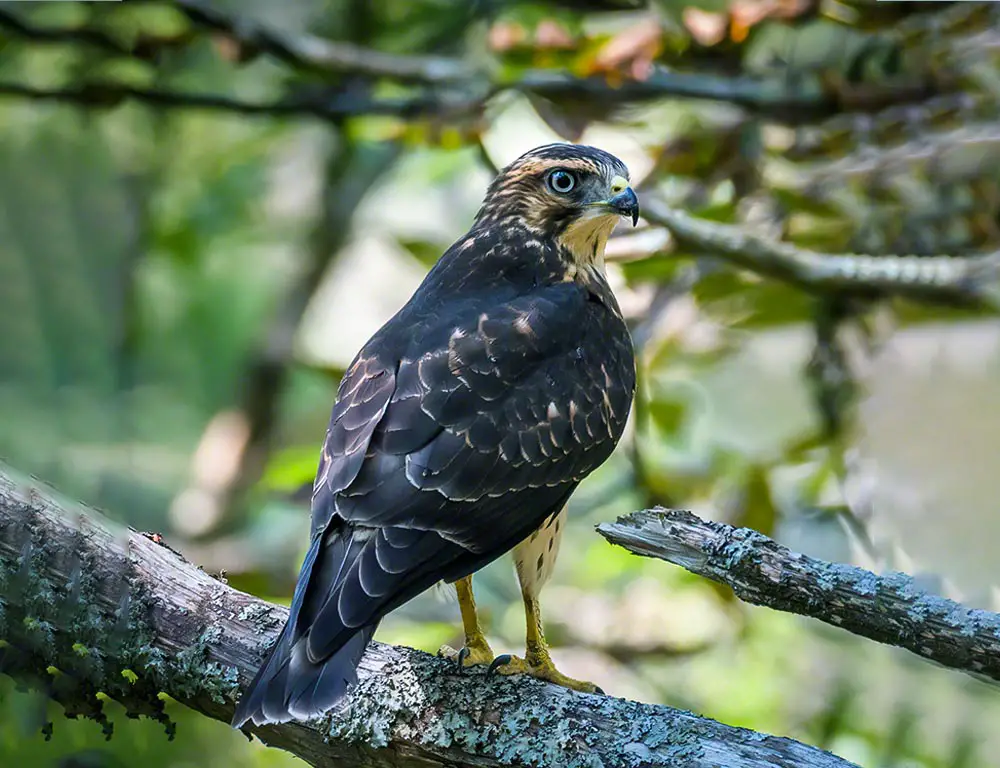
The broad-winged hawk is a type of hawk that is medium in size. It belongs to the genus Buteo. Some subspecies of this hawk are found in eastern North America during the summer. These subspecies can be found as far west as British Columbia and Texas.
However, when the winter season arrives, these hawks migrate to the Neotropics. The Neotropics is a region that extends from Mexico to southern Brazil. During the summer, the broad-winged hawk can be seen in various parts of eastern North America.
This includes areas as far west as British Columbia and Texas. These hawks prefer to reside in this region during the warmer months. They build their nests and raise their young in these areas.
However, when the temperature starts to drop and the winter season approaches, the broad-winged hawks begin their migration. They leave their summer homes in eastern North America and travel towards the Neotropics.
The Neotropics provide a more suitable environment for them during the colder months. The migration of these hawks takes them on a long journey. They fly southwards from their breeding grounds, crossing vast distances.
They travel through different regions, adapting to changing landscapes and weather conditions.
| Kingdom | Animalia |
| Phylum | Chordata |
| Class | Aves |
| Order | Accipitriformes |
| Family | Accipitridae |
| Genus | Buteo |
| Species | B. platypterus |
6. Rough-legged Buzzard
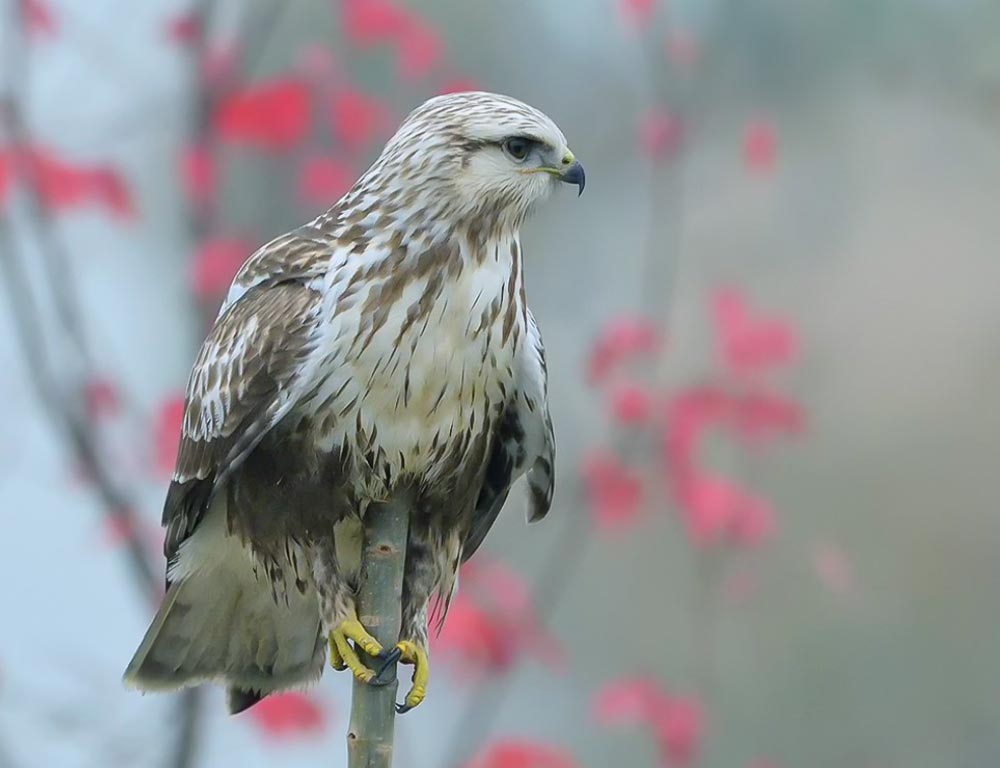
The rough-legged buzzard, also known as the rough-legged hawk, is a bird of prey that is medium-large in size. It can be found in the Arctic and Subarctic regions of North America, Europe, and Russia. During the breeding season, these buzzards make their home in these regions.
However, when winter arrives, they migrate south. These birds are well-suited to survive in the harsh Arctic and Subarctic climates. They have adapted to the cold weather and snowy landscapes of these regions.
The rough-legged buzzard has several physical characteristics that help it thrive in these environments. One of the distinctive features of the rough-legged buzzard is its feathered legs.
These feathers extend down to its feet, providing insulation against the cold temperatures.
This adaptation allows the bird to maintain its body heat and prevents frostbite. The rough-legged buzzard also has a large wingspan, which helps it soar through the air effortlessly. This enables the bird to cover long distances during migration and efficiently search for prey.
Their wings are broad and rounded, making them well-suited for gliding and hovering. When it comes to hunting, the rough-legged buzzard primarily feeds on small mammals, such as rodents. It has.
| Kingdom | Animalia |
| Phylum | Chordata |
| Class | Aves |
| Order | Accipitriformes |
| Family | Accipitridae |
| Genus | Buteo |
| Species | B. lagopus |
7. Osprey
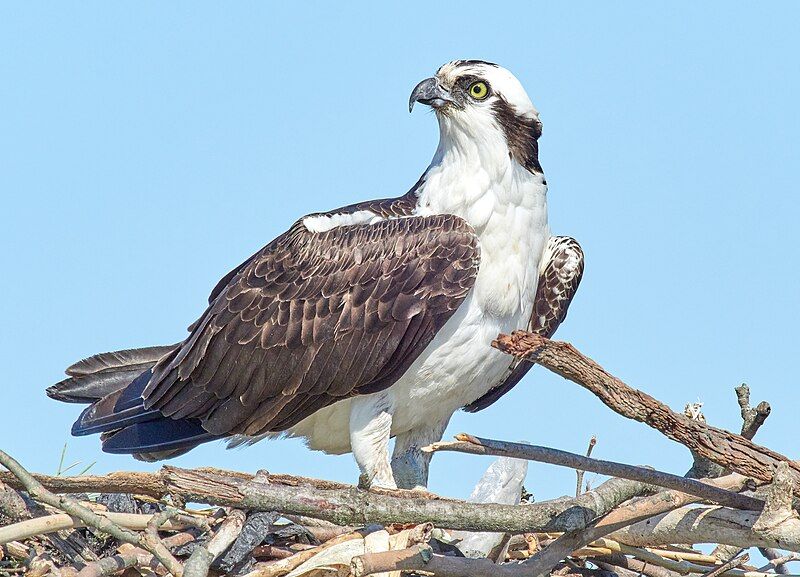
The osprey is a type of bird that is also known by different names such as sea hawk, river hawk, and fish hawk. It is a bird of prey that hunts and eats fish, and it is active during the daytime, which means it is diurnal.
The osprey can be found in various parts of the world, as it has a cosmopolitan range. In terms of size, the osprey is considered to be a large bird. It can grow to be more than 60 cm long, and its wingspan can reach up to 180 cm.
This makes it quite impressive when it takes flight and soars through the sky. In terms of appearance, the osprey has distinct coloring. The upper parts of its body are brown, which helps it blend in with its surroundings when perched on trees or other structures.
However, its head and underparts are predominantly greyish. This coloring may provide some camouflage when the osprey is near bodies of water, where it hunts for fish. Overall, the osprey is a fascinating bird with unique characteristics.
Its ability to hunt fish, its large size, and its distinct coloring make it a remarkable species to observe in its natural habitat.
| Kingdom | Animalia |
| Phylum | Chordata |
| Class | Aves |
| Order | Accipitriformes |
| Family | Pandionidae |
| Genus | Pandion |
| Species | P. haliaetus |
8. American Kestrel
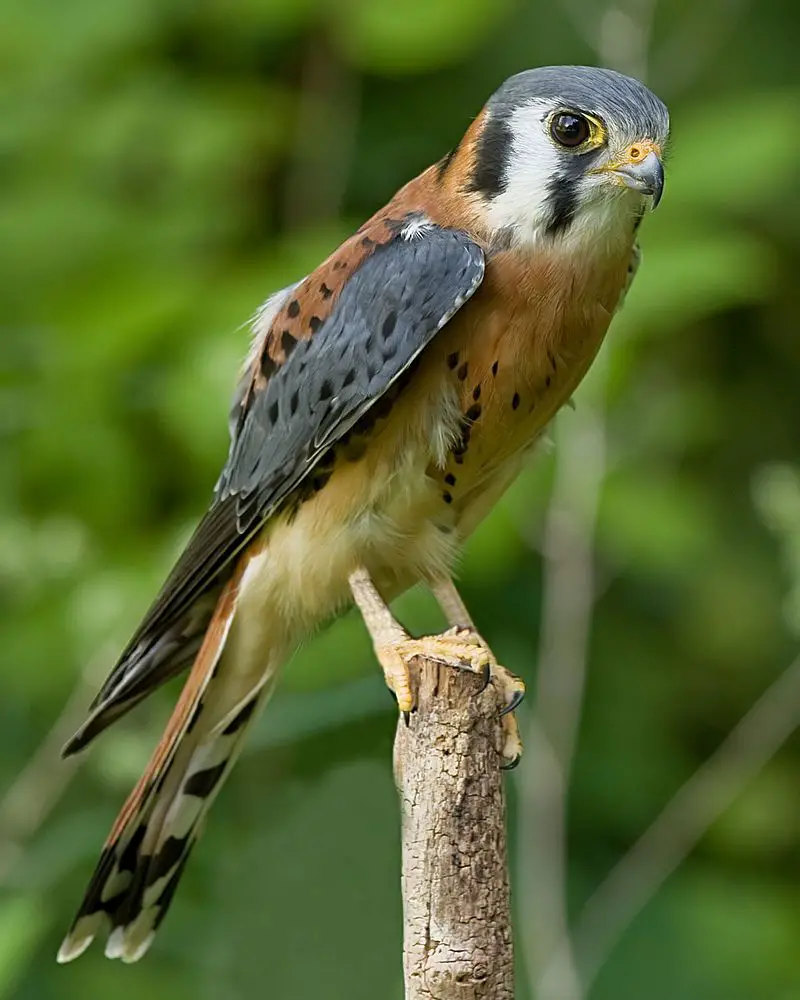
The American kestrel is a type of falcon that can also be known as the sparrow hawk. It is found in North America and is the smallest and most common falcon in the region. The size of the American kestrel can vary depending on the subspecies and the sex of the bird.
Generally, there is a two-to-one range in size between different individuals. When it comes to size, the American kestrel can range from being as small as a blue jay to as large as a mourning dove.
This means that some individuals can weigh as much as a blue jay, while others can be as heavy as a mourning dove. The variation in size within the American kestrel population can be attributed to differences in subspecies and also between males and females.
This means that females may generally be larger than males, and different subspecies may have different average sizes. It is interesting to note that despite this size variation, the American kestrel remains the smallest falcon in North America.
This indicates that even the largest individuals of this species are still relatively small compared to other falcons found in the region. In conclusion, the American kestrel, is also known as the sparrow.
| Kingdom | Animalia |
| Phylum | Chordata |
| Class | Aves |
| Order | Falconiformes |
| Family | Falconidae |
| Genus | Falco |
| Species | F. sparverius |
9. Bald Eagle

The bald eagle is a type of bird that lives in North America. It is considered a bird of prey, which means it hunts and feeds on other animals. This majestic bird is also known as a sea eagle. There are two known subspecies of the bald eagle.
Subspecies are variations of a species that have slightly different characteristics but can still interbreed. These subspecies of the bald eagle might have some differences in appearance or behavior. The bald eagle is closely related to another bird called the white-tailed eagle.
These two birds form a species pair, which means they are similar and occupy similar ecological niches.
The white-tailed eagle is found in the Palearctic region, which includes Europe, Asia, and Africa. Occupying the same niche means that both the bald eagle and the white-tailed eagle have similar roles in their respective ecosystems.
They both have adaptations that help them survive and thrive in their environments.
They might compete for similar food sources or have similar hunting strategies. In the Palearctic region, where the white-tailed eagle is found, it fulfills a similar ecological role as the bald eagle does in North America.
This means that both species have evolved to fill a specific niche or role in their habitats.
| Kingdom | Animalia |
| Phylum | Chordata |
| Class | Aves |
| Order | Accipitriformes |
| Family | Accipitridae |
| Genus | Haliaeetus |
| Species | H. leucocephalus |
10. Great Horned Owl
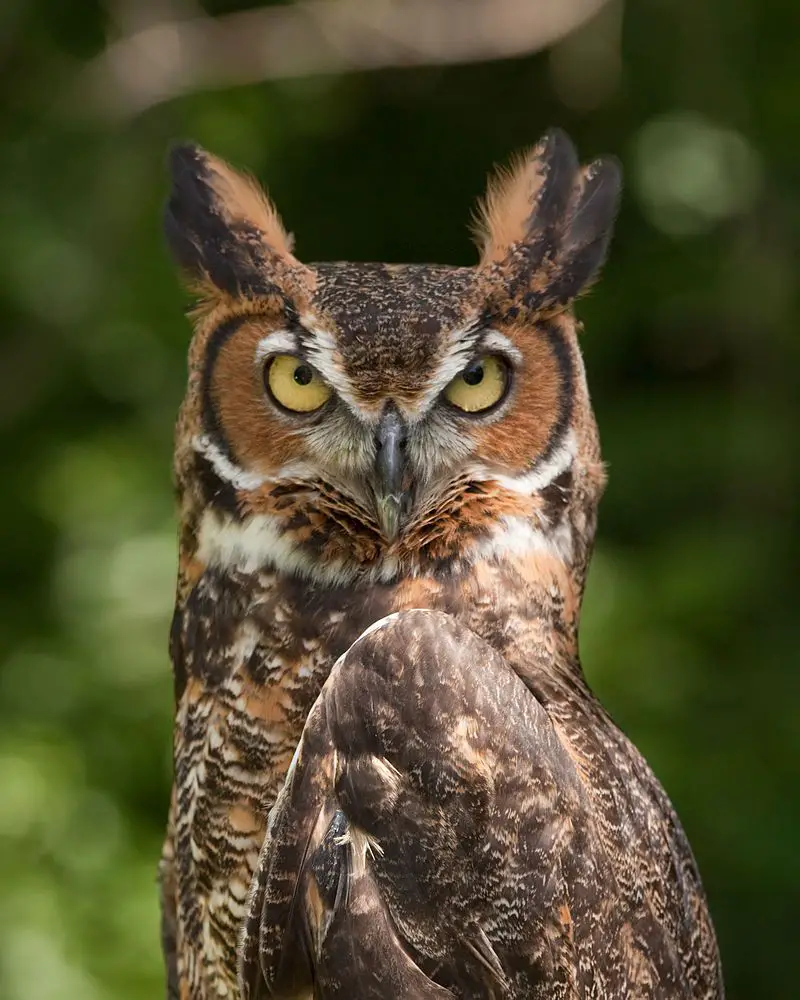
The great horned owl is a species of owl found in the Americas. It is also known by other names such as the tiger owl and the hoot owl.
This owl is known for its adaptability and can be found in various habitats across its wide range. Being a large owl, the great horned owl has a distinct appearance. It has prominent ear tufts on its head, which give it a horned appearance.
This characteristic distinguishes it from other owl species. One of the remarkable traits of the great horned owl is its adaptability. It can be found in a wide range of habitats, including forests, deserts, mountains, and even urban areas.
This versatility allows the owl to thrive in diverse environments and makes it the most widely distributed true owl in the Americas. The great horned owl is a skilled hunter, preying on a variety of animals. Its diet includes small mammals like rabbits, mice, and rats.
Additionally, it feeds on birds, reptiles, amphibians, and even other owls. This owl species has excellent hunting abilities. It possesses sharp talons and a powerful beak, which it uses to catch and kill its prey.
Its wings are designed for silent flight, allowing it to approach.
| Kingdom | Animalia |
| Phylum | Chordata |
| Class | Aves |
| Order | Strigiformes |
| Family | Strigidae |
| Genus | Bubo |
| Species | B. virginianus |
11. Peregrine falcon

The peregrine falcon is a type of bird of prey that is found all around the world. It is also sometimes called the peregrine or the duck hawk in North America. The peregrine falcon belongs to the Falconidae family. One characteristic of the peregrine falcon is its size.
It is quite large, similar to the size of a crow. This falcon has a blue-grey color on its back, with white underparts that are marked with bars. Its head is black in color.The peregrine falcon is particularly famous for its speed.
It is known to be one of the fastest birds in the world. This falcon can fly at incredibly high speeds when it is hunting for its prey. Its swift flying ability is truly remarkable.Being a bird of prey, the peregrine falcon hunts and feeds on other animals.
It primarily preys on birds, catching them mid-air during flight. This falcon has sharp talons that help it catch and hold onto its prey.
Its hunting technique is both impressive and efficient. The peregrine falcon is a cosmopolitan bird, meaning it can be found in various parts of the world. It.
| Kingdom | Animalia |
| Phylum | Chordata |
| Class | Aves |
| Order | Falconiformes |
| Family | Falconidae |
| Genus | Falco |
| Species | F. peregrinus |
12. Northern Goshawk

The Eurasian goshawk is a bird of prey that belongs to the Accipitridae family. This family includes other diurnal raptors like eagles, buzzards, and harriers.
The goshawk is classified as a medium-large bird, which means it is not too small or too big. Being a member of the genus Accipiter, the goshawk is often referred to as a “true hawk.”
This classification distinguishes it from other types of hawks that may have different characteristics or behaviors. As a diurnal bird of prey, the goshawk is active during the day, unlike nocturnal birds that hunt at night.
This means the goshawk relies on its keen eyesight and powerful talons to catch its prey during daylight hours. The goshawk can be found in Eurasia, which is a vast region encompassing Europe and Asia.
It inhabits various types of habitats, including forests, woodlands, and open areas. This adaptability allows the goshawk to thrive in different environments and find suitable prey.In terms of appearance, the goshawk has a distinctive look.
It has a robust body, broad wings, and a long tail. These physical traits enable.
| Kingdom | Animalia |
| Phylum | Chordata |
| Class | Aves |
| Order | Accipitriformes |
| Family | Accipitridae |
| Genus | Accipiter |
| Species | A. gentilis |
13. Eastern Screech Owl

The eastern screech owl, also known as the eastern screech-owl, is a type of small owl. It is commonly found in Eastern North America, spanning from Mexico up to Canada. This owl species is known for its small size, making it relatively easy to identify.
It is not particularly large like some other owl species. The eastern screech owl is considered to be a fairly common sight in its range, which covers a wide geographic area. Despite its name, the eastern screech owl does not only screech.
It has a variety of vocalizations, including whistles and trills. These sounds can be quite distinct and are often heard during the night.
This owl species is known for being vocal and can produce a range of different calls. The eastern screech owl is primarily nocturnal, meaning it is most active during the night.
It spends its days roosting in tree cavities or other hidden areas, using its excellent camouflage to blend in with its surroundings.
This owl’s plumage, or feathers, helps it remain well hidden and protected from predators during the daylight hours. This owl species has adapted well to living in various habitats, including forests, woodlands, and even.
| Kingdom | Animalia |
| Phylum | Chordata |
| Class | Aves |
| Order | Strigiformes |
| Family | Strigidae |
| Genus | Megascops |
| Species | M. asio |
14. Golden eagle
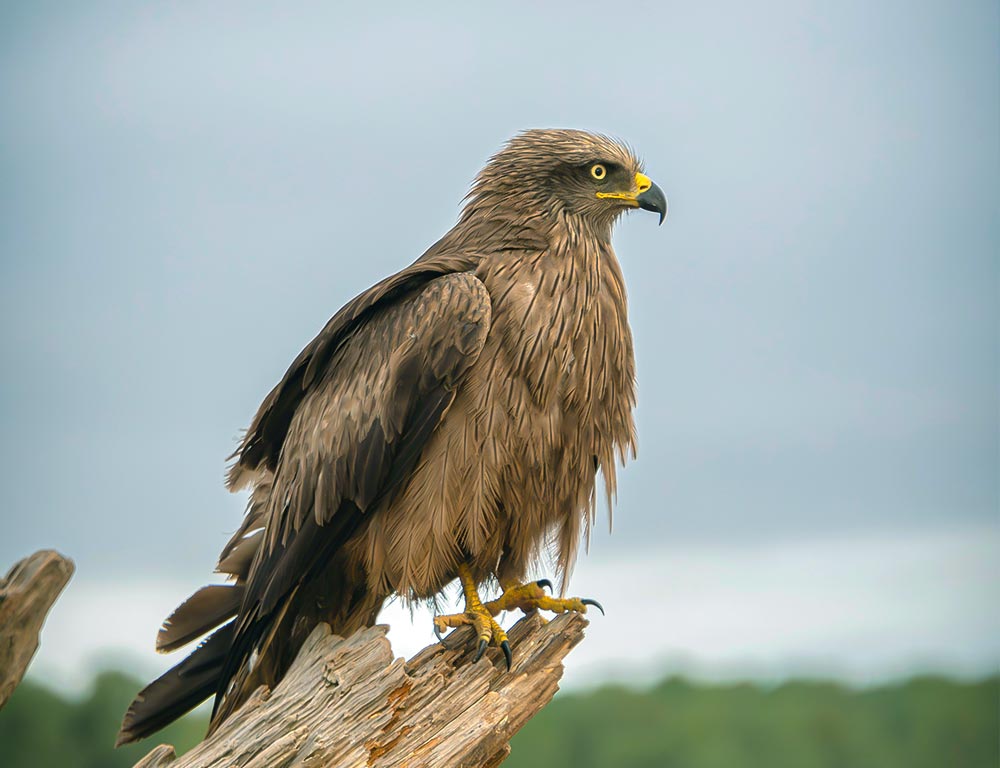
The golden eagle is a majestic bird that can be found in the Northern Hemisphere. It is known for its impressive hunting skills and powerful presence in the sky.
Being the most widely distributed species of eagle, it can be seen across various regions around the world. Belonging to the family Accipitridae, the golden eagle shares its lineage with other eagles and birds of prey.
This family includes a diverse range of species that share common characteristics and hunting techniques. One of the reasons why the golden eagle is so well-known is its status as a formidable bird of prey in the Northern Hemisphere.
Its impressive size, sharp beak, and powerful talons make it a fearsome predator.
It is capable of taking down prey that is larger than itself, demonstrating its remarkable strength and agility. The golden eagle’s habitat spans across a wide range of landscapes, including mountains, forests, and open grasslands.
They are highly adaptable and can thrive in various environments, from arid deserts to snowy mountain peaks.
Their adaptability contributes to their wide distribution and ability to survive in different climates. These birds have a striking appearance, with their golden-brown feathers and impressive wingspan. Their wings can span up to 7.5 feet.
| Kingdom | Animalia |
| Phylum | Chordata |
| Class | Aves |
| Order | Accipitriformes |
| Family | Accipitridae |
| Genus | Aquila |
| Species | A. chrysaetos |
15. Barn owl
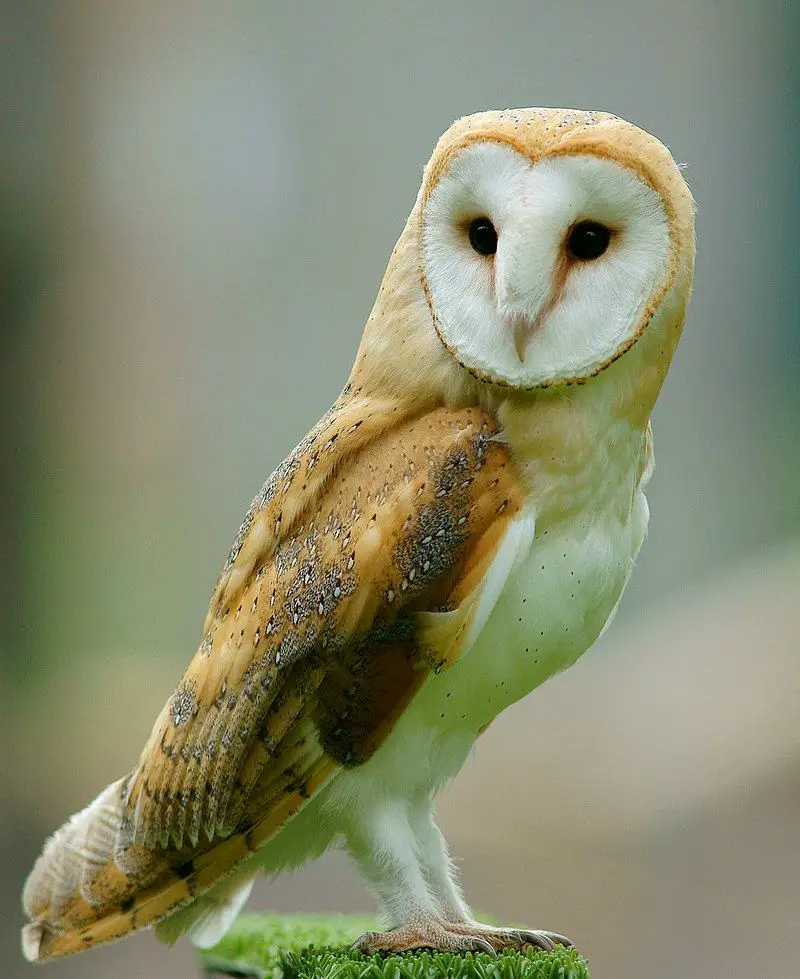
The barn owl is a type of owl that can be found in many different parts of the world. It is the most widely distributed species of owl globally. It is one of the most widespread species of birds overall.
Barn owls can be found in almost every region of the world, with a few exceptions. They are not typically found in polar regions or desert areas. These types of environments do not provide the necessary resources and conditions for the barn owl to thrive.
Additionally, barn owls are not commonly seen in certain parts of Asia, specifically the areas north of the Himalayas. This could be due to a variety of factors, such as the availability of suitable prey or nesting sites. Some islands in Indonesia are also not home to barn owls.
It is unclear why these particular islands do not have barn owls, but it could be due to a combination of geographical, ecological, or historical factors. Furthermore, there are specific Pacific Islands where barn owls are not present.
These islands may lack the necessary resources or habitats for barn owls to survive and reproduce successfully. Overall, the barn owl has a wide distribution and can be found in many parts of the world. However.
| Kingdom | Animalia |
| Phylum | Chordata |
| Class | Aves |
| Order | Strigiformes |
| Family | Tytonidae |
| Genus | Tyto |
| Species | T. alba |
16. Barred Owl
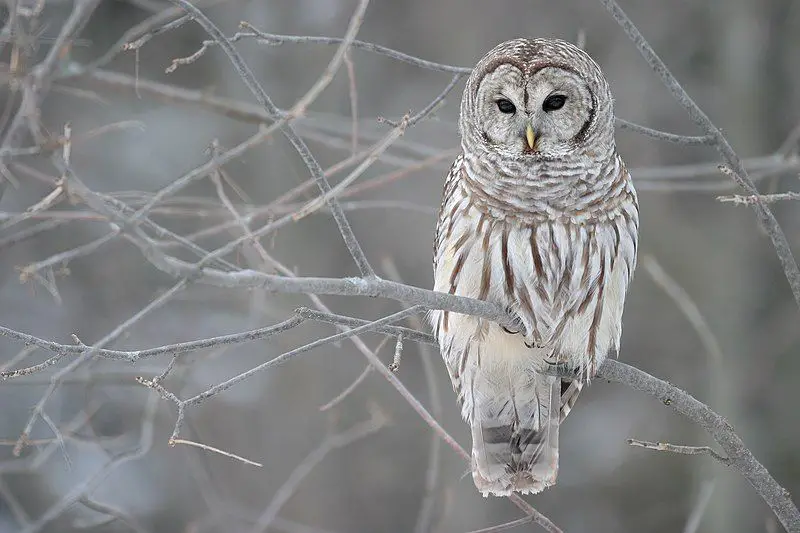
The barred owl is a type of owl that can be found in North America. It is sometimes called the northern barred owl, striped owl, hoot owl, or eight-hooter owl.
This owl is quite large compared to other owls. It belongs to a family of owls called Strigidae, which are known as true owls. The barred owl specifically belongs to the genus Strix.
The name of the family, Strigidae, actually comes from the genus Strix. Linnaean taxonomy is a system of naming and classifying organisms that was created by Carl Linnaeus, a Swedish botanist.
This system organizes living organisms into different categories based on their characteristics. The barred owl’s scientific name is Strix varia.In Linnaean taxonomy, the genus name comes first, followed by the species name.
So for the barred owl, Strix is the genus and varia is the species.
This helps scientists and researchers identify and study different species. The barred owl is known for its distinctive call, which sounds like “who-cooks-for-you, who-cooks-for-you-all.” This call is often heard at night, which is why it is sometimes referred to as a hoot owl.
| Kingdom | Animalia |
| Phylum | Chordata |
| Class | Aves |
| Order | Strigiformes |
| Family | Strigidae |
| Genus | Strix |
| Species | S. varia |
17. Northern Saw-whet Owl
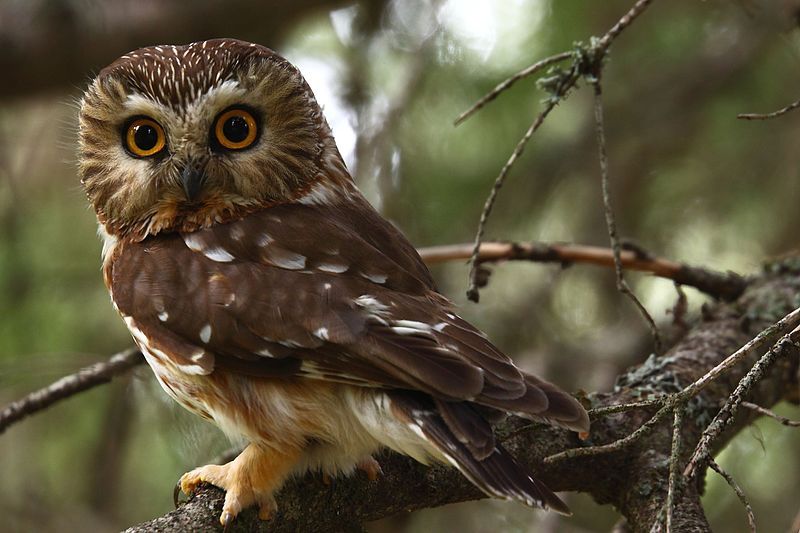
The northern saw-whet owl belongs to the family Strigidae and is a small species of owl. It is originally from North America. This type of owl is part of the genus Aegolius and is known for being one of the smallest owl species in North America.
They are commonly found in dense thickets, where they tend to stay at eye level, making them easier to spot. However, they can also be observed perched up to about 20 feet above the ground.
The northern saw-whet owl is well-adapted to its habitat, which includes forests and woodlands. They have excellent camouflage skills, blending in with the surrounding trees and vegetation.
These owls are mainly active during the night, using their keen eyesight and hearing to hunt for prey. Their diet mainly consists of small mammals, such as mice and voles. Despite their small size, saw-whet owls have a distinctive call.
Their vocalizations are often described as a repetitive, high-pitched tooting sound, similar to the noise made by a saw being sharpened. Breeding season for these owls typically occurs during the spring. The female lays a clutch of eggs in a tree cavity or abandoned.
| Kingdom | Animalia |
| Phylum | Chordata |
| Class | Aves |
| Order | Strigiformes |
| Family | Strigidae |
| Genus | Aegolius |
| Species | A. acadicus |
18. Merlin

The merlin is a type of falcon that can be found in various parts of the Northern Hemisphere. It is known for its small size compared to other falcon species.
The merlin has several subspecies that exist in different regions of North America and Eurasia. These falcons are widely distributed across their habitat range and can be found in diverse environments. They can be seen in forests, grasslands, and even urban areas.
The ability of the merlin to adapt to various habitats contributes to its widespread presence. In North America, the merlin has different subspecies that are found in distinct regions.
For example, there is the prairie merlin, which is primarily found in the central grasslands of the continent. On the other hand, the taiga merlin inhabits the boreal forests of Canada and Alaska. In Eurasia, the merlin also has varied subspecies.
They can be found in different countries such as Russia, Norway, and Sweden, among others. Each subspecies may have specific adaptations and characteristics that suit their particular environment. The Merlin falcon is known for its agility and speed.
It is a skilled hunter, capable of catching swift-flying prey such as small birds and insects.
| Kingdom | Animalia |
| Phylum | Chordata |
| Class | Aves |
| Order | Falconiformes |
| Family | Falconidae |
| Genus | Falco |
| Species | F. columbarius |
19. Short-eared Owl
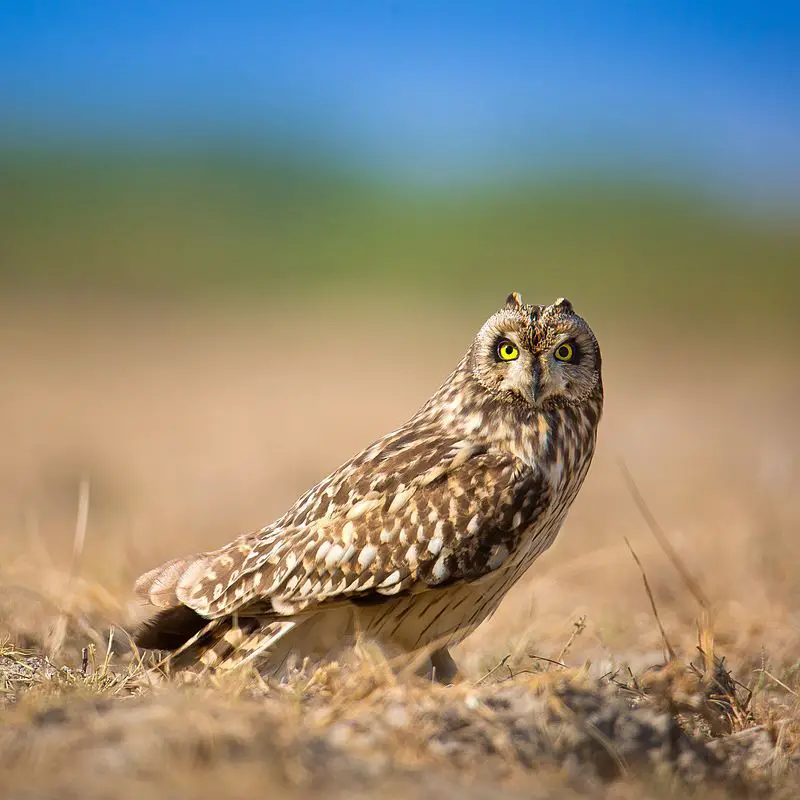
The short-eared owl is a type of owl that can be found in many grasslands around the world. It belongs to the family Strigidae, which is a group of birds that includes various species of owls.
Now, within the family Strigidae, there is a specific group of owls called the eared owls. The eared owls are known for having tufts of feathers on their heads that resemble mammalian ears.
These tufts are often referred to as “ear” tufts because they look like ears, although they are not ears. It’s important to note that not all eared owls necessarily have visible ear tufts.
Some eared owls may have ear tufts that are easily seen, while others may have tufts that are more hidden or not visible at all. This variation in visibility of the ear tufts is observed among different species within the eared owl genus, which is called Asio.
In summary, the short-eared owl is a widespread grassland species that belongs to the eared owl genus, Asio. Eared owls are known for having tufts of feathers resembling mammalian ears, although these tufts may or may not.
| Kingdom | Animalia |
| Phylum | Chordata |
| Class | Aves |
| Order | Strigiformes |
| Family | Strigidae |
| Genus | Asio |
| Species | A. flammeus |
20. Hawk

Hawks belong to the family Accipitridae and are known as birds of prey. These birds are found in various locations around the world, except for Antarctica. They have a wide distribution and can be seen on all continents.
The subfamily Accipitrinae consists of different types of hawks, such as goshawks, sparrowhawks, sharp-shinned hawks, and several others. These species share common characteristics and are closely related to each other.
Goshawks are a type of hawk that belongs to the subfamily Accipitrinae. They are known for their agile and powerful flying abilities. Goshawks have sharp talons and a strong beak that they use to catch and feed on their prey.
They are often found in forested areas, where they hunt small to medium-sized birds and mammals. Sparrowhawks, another member of the Accipitrinae subfamily, are smaller in size compared to goshawks. They are known for their exceptional agility and speed.
Sparrowhawks have specialized flight techniques that enable them to navigate through dense vegetation while hunting small birds, such as sparrows (hence their name). They have sharp talons and a hooked beak.
| Kingdom | Animalia |
| Phylum | Chordata |
| Clade | Dinosauria |
| Class | Aves |
| Order | Accipitriformes |
| Family | Accipitridae |
21. Mississippi Kite

The Mississippi kite is a type of bird that belongs to the Accipitridae family. It is a small bird of prey, which means it hunts for its food. This bird has narrow and pointed wings, which help it soar through the air with grace.
When it is flying, it often looks like it is floating effortlessly in the sky. It is quite a common sight to see multiple Mississippi kites circling in the same area. These birds are known for their impressive flight abilities.
Their narrow wings allow them to maneuver swiftly and change direction quickly. This makes them skilled hunters, as they can swiftly swoop down on their prey without much effort.
Their graceful flight patterns make them a captivating sight to behold. One interesting behavior of the Mississippi kite is its tendency to circle in the air. This behavior is often observed when there are several kites in the same area.
They fly in circles, following a pattern, and it almost seems like they are dancing in the sky.
This circling behavior could serve multiple purposes, such as searching for food, establishing territory, or even courtship displays. The Mississippi kite is mainly found in North and South America, particularly in the southern parts of the United States. These birds prefer.
| Kingdom | Animalia |
| Phylum | Chordata |
| Class | Aves |
| Order | Accipitriformes |
| Family | Accipitridae |
| Genus | Ictinia |
| Species | I. mississippiensis |
22. Long-eared Owl
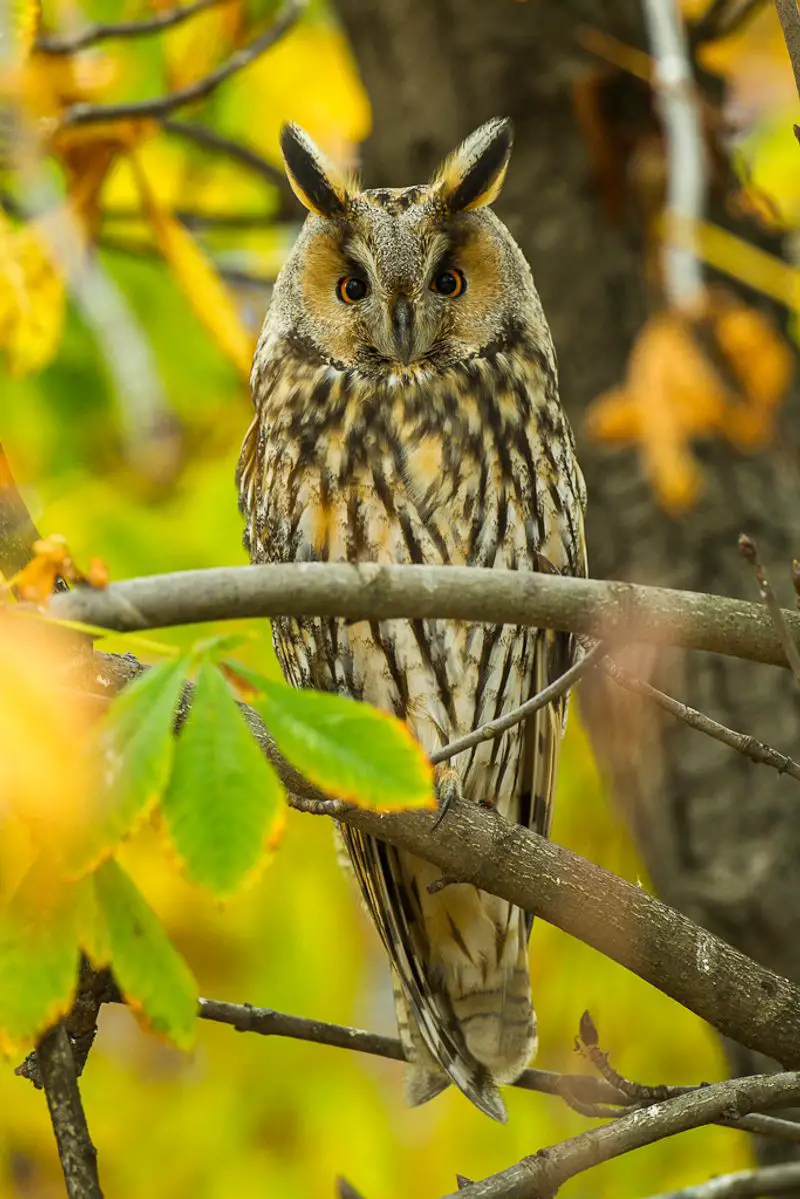
The paragraph introduces the long-eared owl, which is a type of medium-sized owl. It is also known by various names such as the northern long-eared owl, lesser horned owl, or cat owl. This owl species has a wide breeding range.
The scientific name of the long-eared owl is derived from Latin. The paragraph mentions that the genus name of the owl, Asio, represents a type of eared owl. This means that long-eared owls belong to a group of owls that have prominent ear tufts.
Additionally, the term “otus” is also used to describe a small, eared owl. In summary, the long-eared owl is a medium-sized owl that can be called by different names. Its scientific name reflects its association with eared owls, and it has a broad breeding range.
| Kingdom | Animalia |
| Phylum | Chordata |
| Class | Aves |
| Order | Strigiformes |
| Family | Strigidae |
| Genus | Asio |
| Species | A. otus |
23. Eagle

The paragraph introduces the term “eagle” as the common name for the golden eagle, bald eagle, and other birds of prey in the family Accipitridae.
This means that when people refer to eagles, they are generally talking about these specific types of birds. Eagles are part of various groups of genera, which are closely related.
This suggests that while there are different kinds of eagles, they share certain characteristics and have a common ancestry. Among all the groups of genera, the true eagles belong to the genus Aquila.
This means that the golden eagle, bald eagle, and other similar species can be classified as true eagles. Out of the 68 species of eagles, most of them are found in Eurasia and Africa. This information tells us about the distribution of eagles around the world.
It implies that these regions are home to a larger variety of eagle species compared to other parts of the world. To summarize, the paragraph highlights that the term “eagle” encompasses various birds of prey such as the golden eagle and bald eagle.
These eagles belong to different groups of genera, with true eagles falling under the genus Aquila. Furthermore, most of the 68 eagle species are found.
| Kingdom | Animalia |
| Phylum | Chordata |
| Class | Aves |
| Order | Accipitriformes |
| Family | Accipitridae |
24. Harrier

Harriers are a type of hawk that are active during the day, known as diurnal hawks. They are often categorized in the subfamily Circinae within the larger bird of prey family called Accipitridae. What sets harriers apart is their distinctive hunting behavior.
These birds have a particular way of catching their prey – they fly close to the ground. Instead of soaring high in the sky like many other hawks, harriers prefer to fly low over open areas.
This hunting technique allows them to have a better view of the ground and spot potential prey more easily. Harriers have a diverse diet, which mainly consists of small mammals, reptiles, and birds.
They are opportunistic hunters, meaning they will feed on whatever is available in their habitat. Small rodents, such as mice and voles, are commonly targeted by harriers. They also can capture reptiles like snakes and lizards.
Additionally, birds of various sizes can become prey for these hawks. Their low flight pattern enables harriers to locate and pursue their prey more effectively.
Flying at a lower altitude provides them with a better view of the ground, allowing them to spot movement and detect potential prey items. This hunting strategy is especially.
| Kingdom | Animalia |
| Phylum | Chordata |
| Class | Aves |
| Order | Accipitriformes |
| Family | Accipitridae |
| Genus | Circus |
Conclusion
West Virginia is home to a diverse and flourishing population of birds of prey. The state’s diverse topography, including mountains, forests, and rivers, provides ideal habitats for these majestic creatures.
Through conservation efforts and laws protecting their habitats, these birds have been able to thrive in the region. West Virginia residents and visitors are fortunate to have the opportunity to observe and appreciate birds of prey up close in their natural environment.
However, it remains important to continue to monitor and protect these species to ensure their survival and maintain the ecological balance in the state.